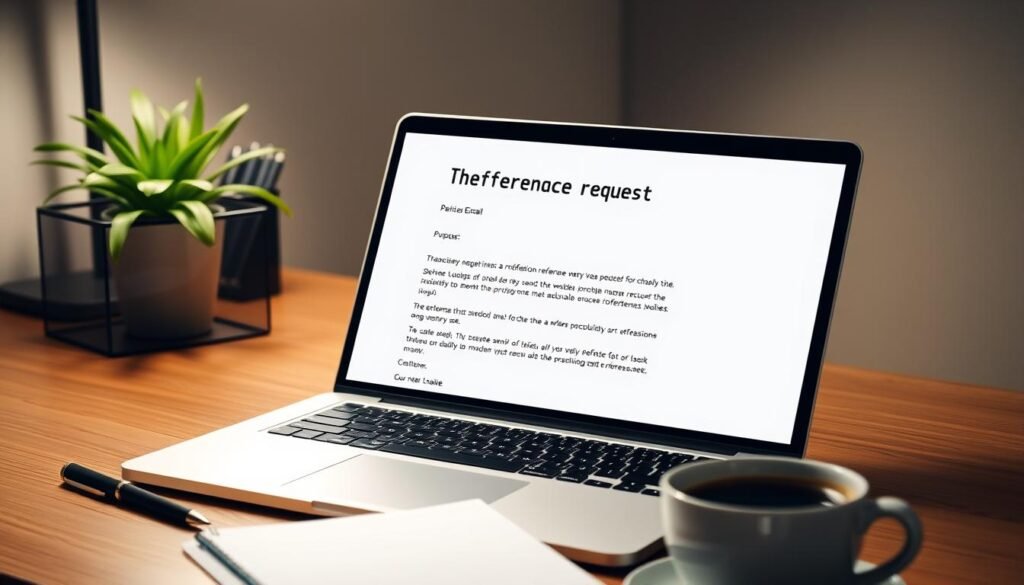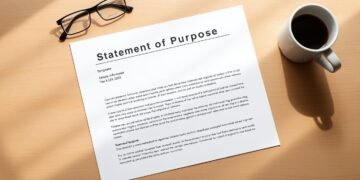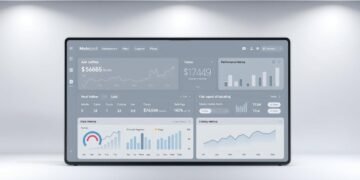Have you ever wondered how much a single reference can impact a hiring decision? In today’s competitive job market, reference checks play a critical role in ensuring the right fit for your team. Employers rely on them to verify skills, assess cultural alignment, and reduce hiring risks.
Crafting an effective reference request email is essential. It sets the tone for professional communication and ensures you gather meaningful insights. A well-structured request not only saves time but also builds trust with candidates and their references.
With 33% of employers conducting continuous screening, as per SHRM data, the importance of structured reference checks is growing. This guide will walk you through the key elements of a successful reference request process, helping you make informed hiring decisions.
Key Takeaways
- Reference checks are vital for verifying candidate qualifications.
- A well-crafted reference request email ensures professionalism.
- Structured reference checks reduce hiring risks significantly.
- Continuous screening is becoming a standard practice in hiring.
- Confidentiality and clarity are crucial in reference communications.
Why Reference Request Emails Are Essential in Hiring
In today’s hiring landscape, gathering reliable insights is more critical than ever. Employers need to verify qualifications and ensure candidates are the right fit for their teams. This is where references play a vital role.
According to CareerOneStop, references help verify 58% of candidates’ claims about their experience. This validation is crucial for making informed hiring decisions. Without it, companies risk hiring employees who may not meet expectations.
Professional references are three times more effective at predicting job success than unstructured interviews. They also provide legal protection by documenting employment history. This reduces the risk of bad hires, which can cost companies up to 30% of an employee’s first-year earnings.
For roles requiring security clearances or sensitive positions, references are indispensable. They validate skills claimed in resumes and interviews, ensuring a comprehensive candidate profile. By leveraging references, employers can make smarter hiring choices and build stronger teams.
Key Elements of a Professional Reference Request Email
Crafting a professional reference request email can make all the difference in hiring. A well-structured message ensures you gather the information needed to make informed decisions. Let’s break down the essential components to include.
Clear Subject Line
The subject line is the first thing recipients see. It should be concise and specific. Including the candidate’s name and job title, like “Reference Check for John Doe – Marketing Manager,” increases response rates by 68%. This approach ensures your email stands out in a busy inbox.
Polite and Concise Introduction
Start with a brief introduction of your company and explain your connection to the candidate. For example, “We’re considering [Name] for the [Position] role and would appreciate your insights.” This sets a professional tone and clarifies the purpose of your email.
Specific Questions for the Reference
Ask targeted questions to gain meaningful insights. Focus on areas like job responsibilities, teamwork, and skills. For instance, “Can you share specific examples of [Name]’s crisis management abilities?” Avoid vague queries to ensure you get actionable information.
When addressing sensitive topics like reliability or ethics, phrase questions carefully. For example, “How did [Name] handle challenging situations in your team?” This approach maintains professionalism while gathering essential details.
Finally, ensure your email complies with ADA guidelines for accessibility. Use clear language and avoid jargon to make it easy for all recipients to understand.
How to Structure Your Reference Request Email
Structuring your message effectively can significantly improve response rates. A well-organized email ensures clarity and professionalism in communication. This approach makes it easier for recipients to understand and respond promptly.
Opening Paragraph
Start with a clear purpose. Mention the candidate’s name and the role they’re being considered for. For example, “[Candidate] has listed you as a reference for the [Position] role.” This sets the context and ensures the recipient knows why they’re being contacted.
Body of the Email
Use bullet-point questions to gather specific insights. For instance, “Regarding their 2019-2021 role at XYZ Corp, can you describe their teamwork skills?” Emails with bullet-point questions receive 40% more complete responses. This format is easy to read and ensures you get the information you need.
Closing Paragraph
End with a polite request for a response by a specific time. Include multiple contact information options, such as email, phone, or a calendar link. For example, “Please respond by [date] or schedule a 15-minute call.” Assure confidentiality to build trust and encourage honest feedback.
Finally, ensure your email complies with legal requirements. Include a brief disclaimer if necessary, depending on your state’s regulations. This protects both you and the recipient during the process.
Choosing the Right References to Request
Selecting the right references is a critical step in the hiring process. The quality of the references you choose can significantly impact the insights you gather about a candidate. A well-rounded mix of professional and personal references ensures a comprehensive evaluation of the candidate’s skills and experience.
Professional vs. Personal References
Professional references, such as former supervisors or colleagues, are often the most valuable. They provide firsthand insights into the candidate’s work ethic, skills, and performance in a professional setting. According to recent data, 78% of HR managers prefer direct supervisors as references.
Personal references, on the other hand, can offer a glimpse into the candidate’s character and interpersonal skills. However, they are less effective for verifying technical abilities or job-specific experience. For entry-level roles, professors or mentors can be valuable references, while executive roles may require input from clients or industry peers.
Former Supervisors and Colleagues
Former supervisors are ideal for understanding how a candidate performed in their previous roles. They can provide detailed examples of the candidate’s leadership, problem-solving abilities, and teamwork. Colleagues, especially those who worked closely with the candidate, can offer insights into their collaboration and communication skills.
When selecting references, avoid those from unrelated positions or outdated contacts. An ideal reference mix includes two managers, one peer, and one subordinate. This combination provides a balanced perspective on the candidate’s abilities and work style.
For self-employed candidates, verify their experience through client testimonials or project-based references. If a former supervisor is unavailable, consider reaching out to the HR department for verification. LinkedIn can also be a useful tool for validating references and ensuring their credibility.
Sample Reference Request Email Templates
Effective communication is key when reaching out for professional insights. Using well-crafted templates ensures clarity and consistency in your messages. Whether you’re reaching out via email or phone, having a structured approach saves time and improves response rates.
Template for Email Responses
An email template with fillable brackets makes it easy to customize your message. For example: “Dear [Reference Name], I’m reaching out to discuss [Candidate Name]’s qualifications for the [Position] role. Could you share your insights on their [specific skill]?” This format ensures professionalism and clarity.
Mobile-friendly HTML formatting is essential for accessibility. Use simple fonts and avoid large blocks of text. ADA-compliant versions should include alt text for images and clear headings for screen readers.
Customize the template with your company branding. Add your logo and use your brand colors to create a cohesive look. This small touch can make your message more recognizable and trustworthy.
Template for Phone Call Requests
For phone calls, start with a friendly icebreaker. For example: “Hi [Reference Name], I hope you’re doing well. I’m calling to discuss [Candidate Name]’s experience with [specific project or role].” This approach sets a positive tone for the conversation.
Include multiple contact information options in your follow-up. For instance, “Feel free to reply via email or schedule a call using this Calendly link.” This flexibility increases the chances of a response.
Follow-up templates are equally important. A simple “Thank you for your initial insights. Do you have any additional details to share?” can encourage further engagement. Calendar integration examples, like Calendly links, make scheduling effortless for both parties.
Common Mistakes to Avoid in Reference Request Emails
Avoiding pitfalls in reference communications can make or break your hiring process. Even small errors can lead to missed opportunities or legal issues. By focusing on clarity and professionalism, you can ensure a smooth and effective process.
Generic Templates
Using generic templates is one of the most common mistakes. Phrases like “To Whom It May Concern” reduce response rates by 38%. Personalized messages, on the other hand, improve response quality by 62%. Tailor your template to include the candidate’s name and specific details about the role.
Another issue is overlooking the reference’s current position or relationship with the candidate. Always verify their connection to ensure the information you receive is relevant and accurate.
Lack of Clarity
Vague questions can lead to unhelpful responses. Instead of asking, “Was John a good employee?” focus on behavior-specific inquiries. For example, “Can you describe John’s contribution to the 2021 system migration?” This approach provides actionable insights into the candidate’s skills and experience.
Timezone mismatches in phone requests can also cause delays. Always confirm the reference’s availability and timezone before scheduling a call. This small step shows respect for their time and increases the likelihood of a prompt response.
Finally, avoid legal pitfalls by steering clear of prohibited questions about age, disability, or other protected categories. Stick to job-related topics to maintain professionalism and compliance.
Best Practices for Following Up on Reference Requests
Timely follow-ups ensure you gather the insights needed for informed decisions. A structured approach not only improves response rates but also keeps the hiring process on track. Let’s explore how to follow up effectively without overwhelming your contacts.
Timing Your Follow-Up
Timing is critical when reaching out. Research shows that 71% of references respond within 72 hours when contacted on Tuesday mornings. Start with an initial email and follow up with a phone call if needed.
An optimal sequence includes a reminder email on day 3 and a polite phone call on day 7. This approach balances persistence with respect for the recipient’s time. Avoid frequent reminders, as they can come across as pushy.
Polite Reminders
When crafting reminder messages, keep them concise and professional. Use a template like, “Following up on my below email from [date].” Include read receipts to track responses and adjust your strategy accordingly.
For unresponsive references, try alternative contact methods, such as LinkedIn messages or SMS. CRM integration can also help track responses and automate follow-ups, saving you time.
Always respect legal boundaries. Avoid persistent follow-ups that could be seen as harassment. Instead, let know the recipient you value their input and appreciate their cooperation.
Conclusion
Mastering the art of reference checks is essential for making informed hiring decisions. A well-structured process ensures you gather accurate and meaningful information about candidates. From crafting clear subject lines to asking specific questions, every detail matters.
Emerging trends like video reference checks and AI verification tools are transforming the way employers validate candidate backgrounds. These innovations add depth to traditional methods, providing more comprehensive insights.
Before sending out your next reference email, double-check the essentials: a customized subject line, targeted questions, and a clear deadline. Remember, references can prevent up to 25% of bad hires, making them a critical part of the hiring process.
For a seamless experience, download our ready-to-use templates and start building stronger teams today. Your next great hire could be just one well-crafted message away.
FAQ
Why are reference request emails important in the hiring process?
They provide insights into a candidate’s skills, character, and performance, helping employers make informed decisions.
What should a clear subject line include in a reference request email?
A concise and specific subject line, such as “Request for Reference for [Position Name],” ensures the recipient understands the purpose immediately.
How can I make my reference request email polite and professional?
Start with a courteous greeting, explain the purpose clearly, and express gratitude for their time and assistance.
What type of questions should I ask in a reference request email?
Focus on specific questions about the candidate’s qualifications, work ethic, and experiences relevant to the role.
How should I structure the body of a reference request email?
Include a brief introduction, explain why you’re reaching out, and provide details about the position or role in question.
Who should I choose as a reference?
Opt for former supervisors, colleagues, or mentors who can speak to your professional skills and experiences.
What are some common mistakes to avoid in reference request emails?
Avoid using generic templates, being unclear about your needs, or failing to provide enough context about the role.
How should I follow up on a reference request?
Send a polite reminder after a reasonable time, ensuring you respect the recipient’s schedule while staying proactive.
Can I request a reference via phone instead of email?
Yes, but always confirm their availability and provide context about the role beforehand to make the process smoother.









